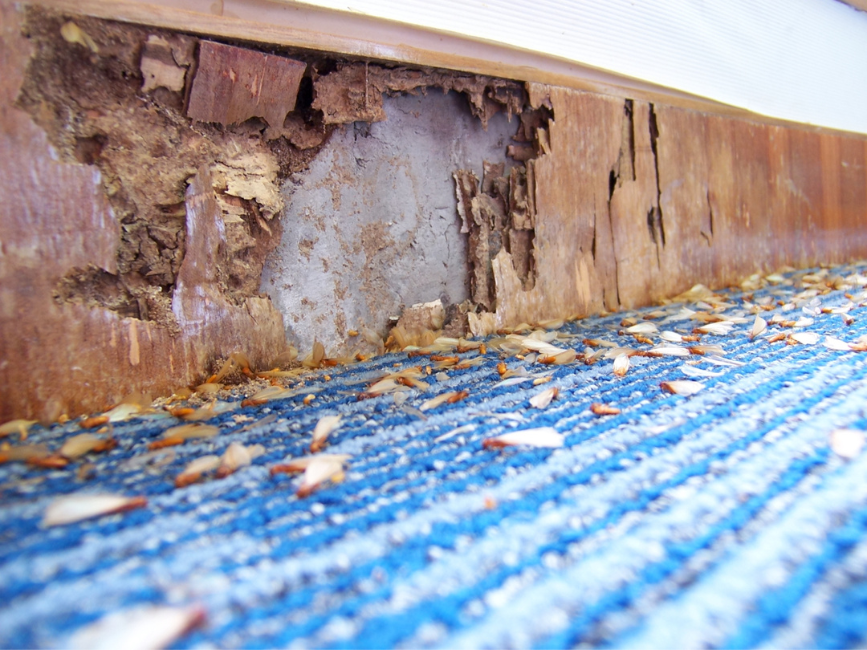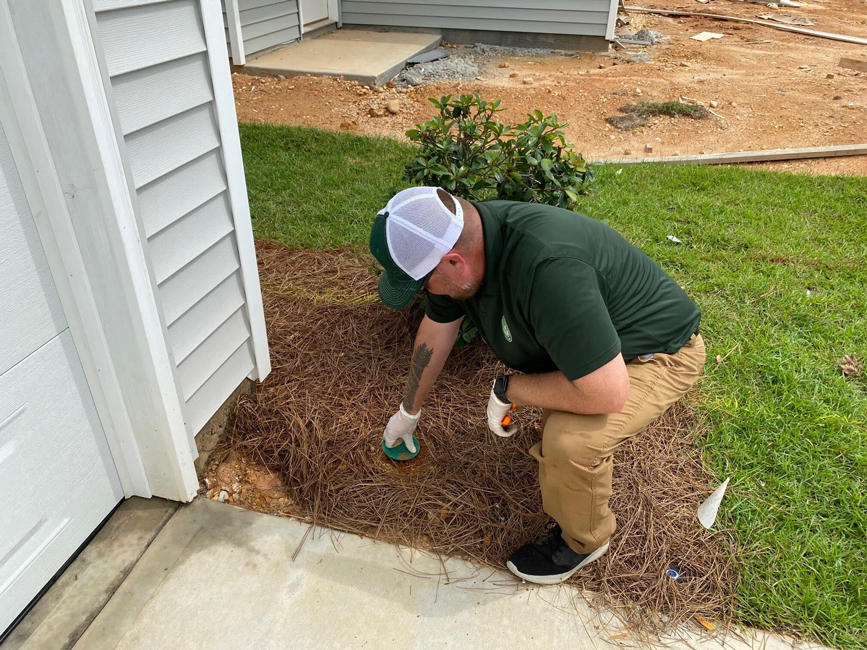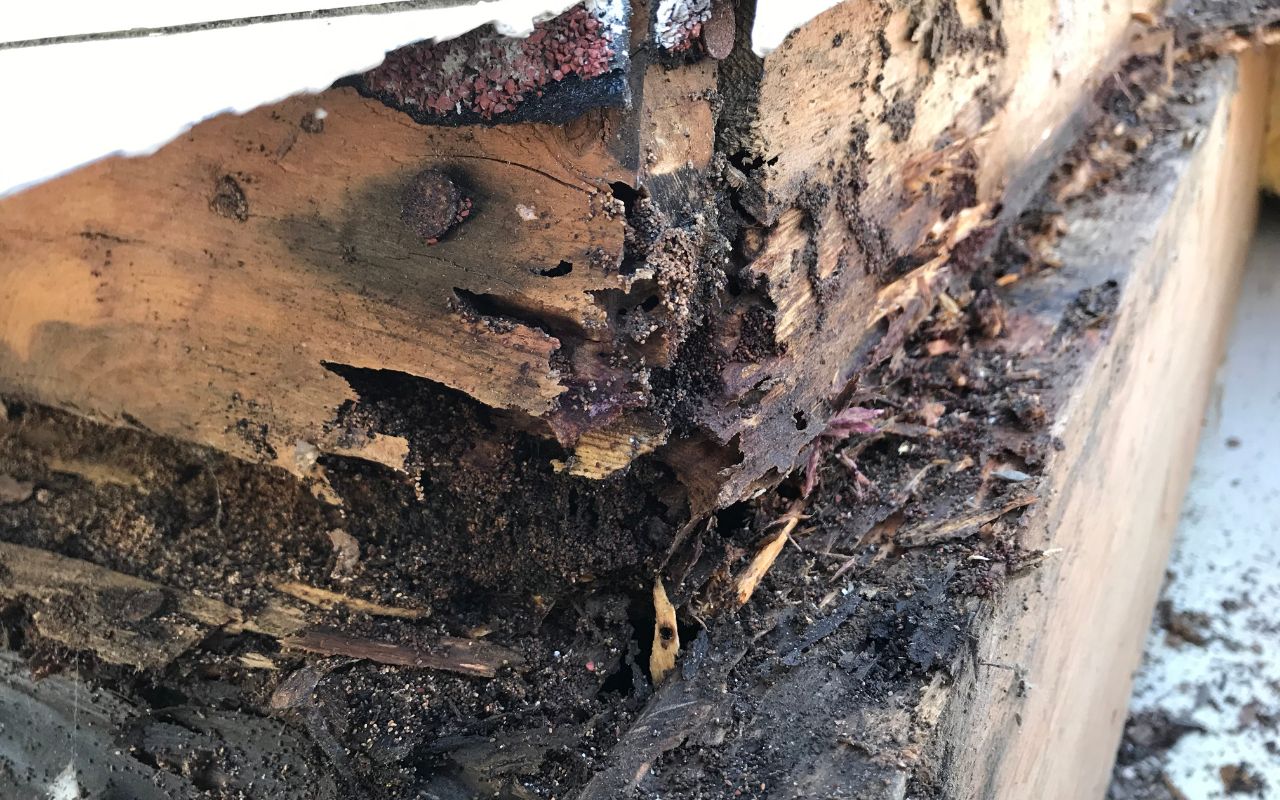Termite Prevention:
How to Protect Your Home
The expression “a penny of prevention is worth a pound of cure” might need some adjustment for inflation, but at least when it comes to termites, prevention is still key! Repairing the damage caused by a typical termite infestation can cost homeowners thousands of dollars on top of the cost of getting rid of the termites themselves!
Today we’re looking at preventative measures that homeowners can (and should) take in order to avoid experiencing termite damage!
What are signs of a termite infestation in my home?
We’ve already done a deep dive on how to recognize the signs of a termite infestation, but here is a quick overview of what to look out for!
- Swarmers: These are young, winged termites that emerge from the colony to start new colonies. Their presence often indicates a nearby termite infestation.
- Discarded Wings: After swarmers take flight, they shed their wings. Finding these discarded wings around your property (typically along window frames) is a common sign of termite activity.
- Mud Tubes: Subterranean termites build these pencil-diameter tubes made of mud, to travel between their colony and food source (your home!) without being exposed to the open air.
- Damaged Wood: Termites consume wood from the inside out, leaving a thin veneer of timber or paint. This results in wood that sounds hollow when tapped.
- Termite Droppings (Frass): These are tiny, wood-colored droppings that termites leave behind. They often resemble sawdust or coffee grounds.
- Bubbling Paint: This can be a sign of moisture build-up due to termite damage. Paint may bubble or peel away from the infested wood.
- Quiet Clicking Noises: You might hear these soft sounds from the walls. It’s the sound of termites communicating by tapping their heads against the wood.
- Tight-Fitting Doors and Windows: As termites consume wood, they can cause frames to warp, making doors and windows difficult to open and close.
- Tunnels in Wood: These are also known as galleries. They are hard to see from the outside but are clear signs of termites if wood is broken open.
The Best Ways to Prevent Termites
Hire a professional
We understand that listing professional pest control services as the most effective way to avoid a termite infestation might sound like a conflict of interest… but a termite bond is a literal guarantee that you will not get termites. And, in the extremely rare event that a termite infestation happens while your home is under bond, the bond means that your pest control company has contractually agreed to pay for both your repairs and the infestation removal.
Choosing the right termite control company is important and we recommend looking for a local pest control company with plenty of good reviews. Be careful choosing a big national brand just because you know the name. In most cases, the big chains are franchises, meaning that the quality of one location is entirely dependent on local ownership. This often means customers end up paying higher prices for less than stellar results. Always check for recent reviews and make an informed decision!
The process of professional termite protection starts with a preliminary termite inspection to ensure that your home is currently free from infestation, After giving your home a clean bill of health, your exterminator will apply long-lasting liquid termiticide (a pesticide which specifically targets termites), install termite bait stations, or both insecticide and bait stations. Afterwards, annual inspection and reapplication of termite treatment is typically all that is needed to keep your home free from termites!
Eliminate any wood in direct contact with your home’s foundation
Today, many homes in termite-prone areas of the country are built on concrete slabs, and this goes a long way to deterring termite colonies from taking up residence. However, if you store firewood or wood piles right again to your home, you are giving termites easy access!
Similarly, you should avoid planting trees and shrubs too close to your home, as termites (and other pests) may take advantage of the shade, humidity, and access they provide.
Finally, don’t allow soil or mulch to come within 6-inches of your home’s siding – there should be a significant buffer between the ground and any part of your home which is wooden.
Should you remove dead trees and stumps from your lawn?
A commonly touted piece of advice is to be sure to remove any dead trees or stumps in your lawn. This makes a certain degree of sense, as dead trees do attract termites, and it would be reasonable to assume that these termites could then make their way into your home.
However, the scientific research is a bit unclear on the matter, with the best studies on termite risk finding only limited connection between proximity to forests (which contain stumps and dead trees) and infestation. The biggest risk is direct ground contact of wooden components such as siding and patio footings. Ultimately, remove your tree stumps if you want, but if you follow best practices, it probably isn’t essential.
Don’t let moisture accumulate near your foundation.
Termites need high levels of moisture in order to thrive, so by keeping the soil around your home dry, you discourage them from visiting. Keeping your gutters in good condition, routing downspouts away from your home, and ensuring that your lawn is properly graded will all help keep termites at bay.
Some sources of water are easy to overlook. If your air conditioner generates lots of condensation, it can saturate the soil in its area and create localized conditions of excess moisture which are favorable for termites. Similarly, fix any leaking faucets to prevent moisture from building up.
Reduce humidity in your crawl space
Crawl spaces are naturally somewhat humid spaces, and can serve as an entry point for these cellulose hungry invaders. One highly effective way to keep crawl space moisture to a minimum is by installing a vapor barrier. Unlike expensive encapsulation projects which require repair-prone dehumidifiers, vapor barriers reduce humidity without requiring any power source or annual maintenance.
Seal any gaps caused by foundation settling
Your home’s foundation is its last line of defense against termites, and so it is essential that any cracks and crevices be sealed. Termites can enter through gaps as thin as a credit card, so even small cracks can give them a pathway into your home. Additionally, foundation cracks can allow water leaks, creating the moisture-rich environment that termites love.
When selecting a sealant or caulk for termite prevention, opt for silicone-based sealants for their durability and moisture resistance, ideal for exterior foundation cracks. For larger gaps, polyurethane foam is effective as it expands to fill spaces thoroughly. Ensure the product is termite-resistant for added protection.
The Best Solution For Termites is Prevention
Termite infestations are expensive and time consuming for homeowners to deal with, but thankfully with some preventative measure they are avoidable! Working with a pest control professional is the best way to keep your home safe – full stop. However, keeping wood debris away from your home, limiting soil moisture, and avoiding any wood-to-ground contact are important steps that should not be overlooked!
Are you ready to get the peace of mind that comes from a guaranteed termite bond? We offer pest management services for the South Carolina Midlands and will keep your home safe!



